PP Woven Geotextile for Long Fibers with High Strength
- Loading Port:
- Qingdao
- Payment Terms:
- TT or L/C
- Min Order Qty:
- 10000 m²
- Supply Capability:
- 100000 m²/month
OKorder Service Pledge
OKorder Financial Service
You Might Also Like
1. Features:
Polyester filament geotextile is made by polyester textile needle consolidation , product specifications from 80-800g/m2 , it is geosynthetic application in geotechnical and civil engineering , they are arranged in three-dimensional structure of the fiber . In addition to having good mechanical properties, but also has a good aspect to the drainage performance and good elongation properties and high resistance to biological , acid , anti-aging chemical stability . Meanwhile , it also has a wide range of pore size , pore distribution tortuous , excellent permeability and filtration performance .
2. Action:
1, Water conservancy project dams and slope of filtration , channel isolation, impervious ;
2, Highways , railways, airport runways based isolation, filtration , drainage, slopes, retaining walls and pavement reinforcement, drainage ;
3, Port engineering soft ground , beach causeway , harbor piers and breakwaters reinforcement, drainage ;
4, Polyester filament geotextile has been widely used in the field of infrastructure construction , and gradually be applied to a wider range of fields.
3. Technical data:
Index | Remark | |||||||||||
100 | 150 | 200 | 250 | 300 | 350 | 400 | 450 | 500 | 600 | 800 | ||
Deviation of mass per unit area % | -6 | -6 | -6 | -5 | -5 | -5 | -5 | -5 | -4 | -4 | -4 | |
Thickness mm ≥ | 0.8 | 1.2 | 1.6 | 1.9 | 2.2 | 2.5 | 2.8 | 3.1 | 3.4 | 4.2 | 5.5 | |
Width deviation % | -0.5 | |||||||||||
Break strength kN/m | 4.5 | 7.5 | 10.5 | 12.5 | 15 | 17.5 | 20.5 | 22.5 | 25 | 30 | 40 | Vertical and horizontal |
Break elongation % | 40~80 | |||||||||||
CBR bursting strength kN ≥ | 0.8 | 1.4 | 1.8 | 2.2 | 2.6 | 3.0 | 3.5 | 4.0 | 4.7 | 5.5 | 7.0 | |
Equivalent aperture mm | 0.07~0.2 | |||||||||||
Vertical permeability cm/s | K*(10-4~10-3) | K=1.0~9.9 | ||||||||||
Tear strength kN≥ | 0.14 | 0.21 | 0.28 | 0.35 | 0.42 | 0.49 | 0.56 | 0.63 | 0.70 | 0.82 | 1.10 | Vertical and horizontal |

FAQ of our geotextile:
- Q: What can we do for the special customer?
A: Provide custom made service with customer's drawing; We make sure to provide you with the best solutions for your individual case. Whether standard items or non-standard items.
- Q: What can we supply?
A: We provide high levels of communication from start to finish.
- Q: What is our advantage?
A: Top Cemented Carbide has extensive business experience, Fast delivery and high quality.


Erosion problems have been with us since man first learned how to cultivate the land he lived in. Fortunately, many solutions have been produced since that time. One such solution is the use of woven geotextiles. Woven geotextiles are a permanent fabric to assist in the retention of soil in many different situations. Their purpose is to provide a porous foundation for separating particles of varying sizes. Another use is to allow moisture to penetrate the material, but restrict plant life from starting.
Erosion control can sometimes involve using something called a "riprap", which is when non-porous objects are used to slow down the velocity of waterflow. Common objects are large stones or concrete slabs. This reduces the chance of damaging the land. When a riprap is constructed, there are usually different particle sizes of material used. To help keep them separated and in place, woven geotextiles can be placed between the different layers. This will help control the flow of water and reduce the chance of erosion of not only the surrounding soil, but the different parts and layers of the riprap.
Woven geotextiles are used in a great deal in landscaping projects. These serve as permanent barriers against any unwanted vegetation from sprouting up in places where they are not wanted. These barriers are commonly placed three to six inches below the surface. Top soil is placed over the top and the ordimental vegetation is then planted. The woven material allows not only water to flow through it, but also provides a protective barrier to help retain the moisture during very hot and dry conditions.
On construction sites, woven geotextiles are commonly used to cover the soil after it has been disturbed by normal activities. When placed over piles of soil, these coverings make it so the piles can withstand downpours from rain and not be turned into nuisance dust by the wind. These are temporary covers that are used until the soil is ready to be used again or put back to where it came from.
Sometimes the woven geotextiles are used as a filter to assist with separating out the fine particles from the larger materials. Occasionally, the material can become clogged and needs to be replaced and the fine materials are redistributed or disposed of.
- Q:What are the advantages of using geotextiles in shoreline stabilization?
- Geotextiles offer several advantages in shoreline stabilization. Firstly, they act as a barrier, preventing erosion caused by waves, tides, and currents. They effectively hold the soil in place, reducing the risk of land loss and maintaining the integrity of the shoreline. Secondly, geotextiles are permeable, allowing water to pass through while retaining the soil particles, which helps in maintaining a stable and balanced ecosystem. Additionally, they are durable and resistant to UV degradation, ensuring a long lifespan and reducing the need for frequent maintenance. Lastly, geotextiles are easy to install and cost-effective compared to traditional methods, making them a practical choice for shoreline stabilization projects. Overall, geotextiles provide a sustainable and efficient solution to protect and enhance coastal areas.
- Q:Geotextile and geogrid the same do
- Not the same, two concepts
- Q:What are the factors that affect the strength of geotextiles?
- The factors that affect the strength of geotextiles include the type and quality of the materials used in their production, the manufacturing process, the density and thickness of the fabric, the presence of any additional reinforcement layers, the level of UV stabilization, and the environmental conditions in which they are used.
- Q:How do geotextiles help with filtration in stormwater management systems?
- Geotextiles help with filtration in stormwater management systems by providing a barrier that allows water to pass through while retaining sediment, silt, and other pollutants. They prevent the clogging of drainage systems, improve water quality, and help in the overall maintenance and effectiveness of stormwater management infrastructure.
- Q:What are the considerations for geotextile selection in landfill projects?
- The considerations for geotextile selection in landfill projects include factors such as the required strength and durability of the geotextile, its ability to resist punctures and tearing, its compatibility with the waste material, and its resistance to chemical degradation. Other factors to consider include the geotextile's permeability, its ability to retain soil particles while allowing for proper drainage, and its cost-effectiveness. Additionally, the geotextile should be selected based on its compliance with regulatory requirements and standards for landfill construction.
- Q:Can geotextiles be used in bridge abutment reinforcement?
- Yes, geotextiles can be used in bridge abutment reinforcement. Geotextiles are commonly used in civil engineering projects, including bridge construction, to improve soil stability, prevent erosion, and provide additional reinforcement. They can be installed behind the abutment walls or embankments to distribute loads, reduce settlement, and increase the overall stability and durability of the structure.
- Q:What are the primary applications of geotextiles?
- Geotextiles are primarily used in civil engineering and construction projects for applications such as soil stabilization, erosion control, filtration, drainage, and reinforcement of soils. They can also be used in environmental projects, agriculture, and transportation infrastructure.
- Q:Are geotextiles suitable for use in reservoir lining?
- Yes, geotextiles are suitable for use in reservoir lining. They are commonly used to prevent soil erosion and provide stability in various civil engineering applications, including lining reservoirs. Geotextiles can help to separate different soil layers, reinforce the reservoir lining, and enhance its overall integrity and durability. Additionally, they can provide filtration and drainage properties, which can be beneficial in reservoir construction and maintenance.
- Q:Composite geotextile 20-500-0.5 what it means
- Should be 200 / 0.5 / 200,200g cloth, o.5 film, wish smooth
- Q:What are the different geotextile puncture resistance test methods?
- There are several geotextile puncture resistance test methods, including the ASTM D4833, ASTM D6241, and ISO 12236. These methods involve subjecting the geotextile to various mechanical forces to determine its resistance to puncture.
1. Manufacturer Overview |
|
|---|---|
| Location | Taian City,Shandong Province,China |
| Year Established | 2008 |
| Annual Output Value | Above US$100 Million |
| Main Markets | Africa, Oceania, North America, Western Europe, Eastern Asia |
| Company Certifications | ISO9001;IS014001 Certificate |
2. Manufacturer Certificates |
|
|---|---|
| a) Certification Name | |
| Range | |
| Reference | |
| Validity Period | |
3. Manufacturer Capability |
|
|---|---|
| a)Trade Capacity | |
| Nearest Port | Qingdao Port;Tianjing Port;Shanghai Port |
| Export Percentage | |
| No.of Employees in Trade Department | 21-30 People |
| Language Spoken: | English; Chinese; |
| b)Factory Information | |
| Factory Size: | 10,000-30,000 square meters |
| No. of Production Lines | Above 10 |
| Contract Manufacturing | Geotechnical Material (Geogrid,Fiberglass/Polyester Geogrid,Geocell,Geonet and Geomat,Plastic Safety Fence) |
| Product Price Range | Average |
Send your message to us
PP Woven Geotextile for Long Fibers with High Strength
- Loading Port:
- Qingdao
- Payment Terms:
- TT or L/C
- Min Order Qty:
- 10000 m²
- Supply Capability:
- 100000 m²/month
OKorder Service Pledge
OKorder Financial Service
Similar products
New products
Hot products
Related keywords

































